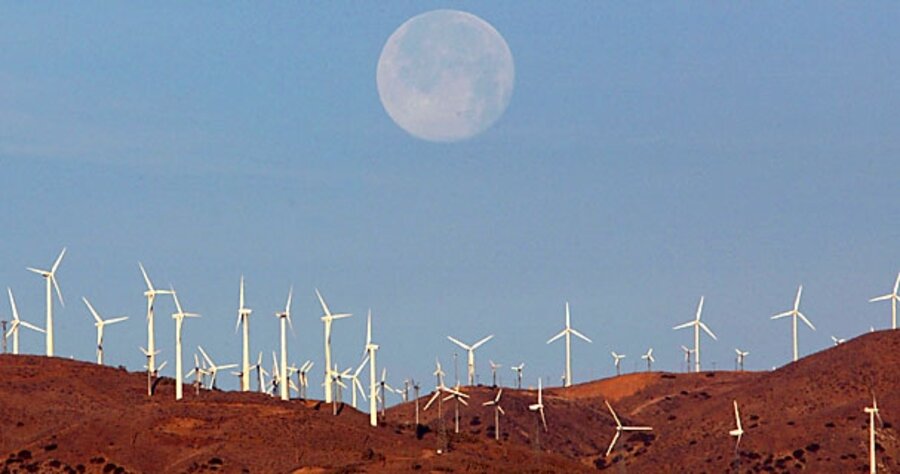California eyes going ‘green’ despite slump
Loading...
| Los Angeles
California moved ahead this week with plans to slash greenhouse-gas emissions to 1990 levels by 2020 and foster a green economy, even as some business groups questioned the costs in difficult economic times.
The California Air Resources Board (CARB) released Wednesday final details of its so-called “Scoping Plan,” that spells out ways to reduce its greenhouse-gas emissions to meet the requirements of the state’s landmark Global Warming Solutions Act of 2006.
The plan combines market-based regulatory approaches, voluntary measures, and fees. Key new measures include reducing leakage of harmful air conditioning and refrigeration gases, expanding commercial recycling programs, and establishing greenhouse-reduction targets for local governments.
“Our comprehensive approach steers California away from its dependence on fossil fuels and accelerates the state’s necessary transition toward a clean energy future,” said Mary Nichols, chairperson of the CARB, which is tasked with implementing the climate law.
But it’s not yet clear how the current economic crisis might affect the plan. Several businesses say that slashing emissions will be costly and harder to achieve during a potential recession.
The California Manufacturers and Technology Association – which represents 165 business organizations – says the Scoping Plan will cause electricity rates to increase by 11 percent, natural-gas rates to rise 8 percent, and gasoline prices to go up $11 billion per year under the plan.
A recent poll here by Fairbanks, Maslin, Maullin & Associates showed that 3 out of 4 voters support state energy policies even if they result in higher prices. The poll was conducted in June before the current financial crisis intensified.
However, Stanley Young, spokesperson for CARB, argues that electricity prices were going to rise anyway. “The price of electricity may rise but the bill that the householder gets could drop which is the benefit of energy efficiency,” he says.
It is possible that costs may rise in the short run and then level off or drop, says Dan Kammen, an energy expert with the University of California, Berkeley. “I suspect prices will rise initially then decline as diversity gets built into the system. Also, the reductions in external gas, oil, and imported electricity get replaced with renewables and [low cost]
energy efficiency,” he says.
Moreover, CARB hopes the plan will create new green jobs – a category estimated to grow by 100,000 or more by 2020. “California’s plan will drive innovation, create thousands of new jobs, and provide a wealth of opportunities for California to export technology and help fight global warming around the world,” said Ms. Nichols.
An economic analysis recently released by the board said implementing the climate law would increase economic production by $27 billion, overall gross state product by $4 billion, overall personal income by $14 billion, and per capita income by $200.
“This is more than a pollution reduction plan, it’s an economic stimulus plan,” says Audrey Chang, climate program director for the Natural Resources Defense Council. “It’s more important than ever during these uncertain times to make investments in clean energy solutions that will stimulate innovation, new businesses and job creation.”
A draft of the Scoping Plan was released in June, and the final one takes into account additional analysis and public input that the Board has received since then – over 40,000 dispatches, “everything from single postcards to 55-page dense analyses,” says Ms. Nichols. The plan is slated to go before the Board for approval at its December meeting.
For some, the Scoping Plan has other flaws. Josh Margolis, joint CEO of CantorCO2e, a financial services company focused on energy and development, is critical of the plan’s cap-and-trade program. Cap-and-trade is a system designed to set limits on emissions and allow companies to trade credits based on the amount they emit. The CARB plans to auction some of these credits and eventually maybe all of them, instead of giving them away, and use the fees generated and use the fees generated to implement new emission-reduction programs.
The program “misses the opportunities that we have enjoyed with other successful cap-and-trade programs like the acid rain and lead phase down programs,” says Margolis. “The focus on auction-generated fees, the transfer of resources out of the hands of the sources and into the government’s hands, is troublesome.”
Nichols admits that much still needs to be ironed out before December. But she hopes California’s experience can become a model for national policy.
California’s climate change law “has already prompted several other states to put mandatory caps on global-warming pollution. Now California’s robust Scoping plan can be a model and a catalyst for national action,” says Derek Walker, director of the California Climate Initiative at Environmental Defense Fund, a co-sponsor of the climate law.





